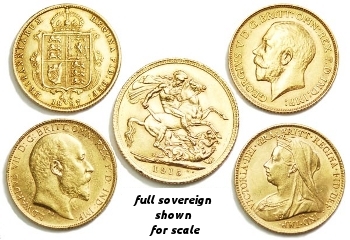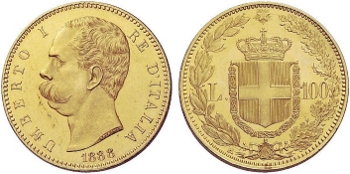Table of Contents
Gold Coins
When there is uncertainty in a nations economy, government or currency, people will use their fiat money to buy precious metals, historically this has been gold or silver and the increased demand in the precious metal causes its value to increase. In some countries, like Switzerland and Liechtenstein, bullion bars can be bought or sold over the counter at major banks but one need not go far to buy gold or silver, it is commonly found in coins but not all coins have precious metals in them. It takes some knowledge to hoard the gold floating around.
British Quintuple Sovereign
British Double Sovereign
- Weight: 15.976 g
- Diameter: 28.40 mm
- Gold: 0.4708 troy oz
- Composition: 22 Carat Gold
British Sovereign (Full)
The British Gold Sovereign is the official coinage of English Royalty and have been issued for both Kings and Queens since they were first minted to honor Henry VII in 1489. Named after the English gold sovereign, last minted in 1604, the name was revived with the Great Recoinage of 1816. Minting these new sovereigns began in 1817. The gold content then was fixed at 113 grains (7.322 g), equivalent to 0.2354 troy ounce, a weight which has remained constant to the present day. 5 of these coins will get you over oz of gold.
 Sovereigns minted since 1817 have been produced to a standard specification:
Sovereigns minted since 1817 have been produced to a standard specification:
- Denomination: nominal value of one pound sterling but in practice used as a bullion coin
- Minted: 1817 - 1917, 1925, from 1957 to present day
- Recognition: small round gold coin, Monarch and St. George slaying dragon or Coat of Arms
- Gold Content: 113 grains = 7.3224 grams = 0.2354 troy ounce
- Diameter: 22.05 mm
- Thickness: 1.52 mm
- Weight: 7.9881 grams
- Fineness: 22 carat = 91.67%
Melbourne During the 1850s, Victoria alone contributed more than one-third of the world’s gold output. Although a Mint opened in Sydney in 1855, it had difficulty keeping pace with the output of the goldfields and in 1871 a new branch of the Royal Mint opened in Melbourne.
Melbourne sovereigns carry a small ‘M’ to identify them.
Sydney Millions of pounds of gold bullion were shipped from Australia to London each year to be minted into coin. However, it soon became apparent that it would be easier to refine the gold and turn it into coins at source, rather than transport it to Britain and have it turned into coins there. Sydney, Melbourne, and Adelaide each submitted to be the venue of a branch of the Royal Mint and after some deliberation the British government awarded it to Sydney, which began issuing coins in 1855. This mint issued coins with its own design from 1855 until 1870 then, in 1871 the Royal Mint insisted that all gold sovereigns regardless of Mint should carry the British design.
The coins minted by Sydney carry a small ‘S’ mintmark to identify them for quality control purposes.
Perth The gold mines at Kalgoorlie and Coolgardie in Western Australia, once discovered, quickly became recognised as two of Australia’s richest. The problems of transporting the raw gold over 2,100 miles to the nearest Mint in Melbourne were obvious and so a new branch of the Royal Mint was authorised and opened in 1899.
Sovereigns minted at Perth carry a small ‘P’ mintmark.
No Edward VIII sovereigns were issued.
British Half Sovereign
 The half sovereign is an English and British gold coin with a face value half that of a sovereign: equivalent to half a pound sterling, ten shillings, or 120 old pence. Since the end of the gold standard, it has been issued only in limited quantities as a commemorative coin with a sale price and resale value far in excess of its face value. The half sovereign was first introduced in 1544 under Henry VIII. After 1604, the issue of half sovereigns, along with gold sovereigns, was discontinued until 1817, following a major revision of British coinage. Production continued until 1926 and, apart from special issues for coronation years, was not restarted until 1980. It was also used extensively in Australia, until 1933.
The half sovereign is an English and British gold coin with a face value half that of a sovereign: equivalent to half a pound sterling, ten shillings, or 120 old pence. Since the end of the gold standard, it has been issued only in limited quantities as a commemorative coin with a sale price and resale value far in excess of its face value. The half sovereign was first introduced in 1544 under Henry VIII. After 1604, the issue of half sovereigns, along with gold sovereigns, was discontinued until 1817, following a major revision of British coinage. Production continued until 1926 and, apart from special issues for coronation years, was not restarted until 1980. It was also used extensively in Australia, until 1933.
- Denomination: nominal value of half of one pound sterling but in practice used as a bullion coin
- Minted: 1817 - 1926 and 1982 - 2005
- Recognition: small round gold coin, Monarch and St. George slaying dragon or Coat of Arms
- Gold Content: 0.1177 troy ounces (3.7 g) of gold (10 coins to an oz)
- Diameter: 19.30 mm
- Weight: 3.99 grams
- Fineness: 22 carat (91⅔ %) gold alloy
Italian Gold Coins
 There were only four kings before Italy became a republic in 1946. Because of its long history, and many small states, many different types and designs of Italian gold coins have been issued. Among the most famous is the ducat, also called a zecchino and issued in numerous states. In other states, its equivalent was the scudo (scudo d'oro) or florin. Double sized coins were doppia, the italian for double, and there were also strangely enough half doppie, quarter doppie and eighth doppie. Sovranos and half sovranos were issued by Lombardy - Venetia, ongaros in Mantua and Milan, doppiettas (little doubles) by Sardinia, oncia by Sicily, ungheros and ruspone in Tuscany.
There were only four kings before Italy became a republic in 1946. Because of its long history, and many small states, many different types and designs of Italian gold coins have been issued. Among the most famous is the ducat, also called a zecchino and issued in numerous states. In other states, its equivalent was the scudo (scudo d'oro) or florin. Double sized coins were doppia, the italian for double, and there were also strangely enough half doppie, quarter doppie and eighth doppie. Sovranos and half sovranos were issued by Lombardy - Venetia, ongaros in Mantua and Milan, doppiettas (little doubles) by Sardinia, oncia by Sicily, ungheros and ruspone in Tuscany.
Lire were introduced as early as 1758 in Genoa, and were eventually also issued by a number of other states including Sardinia. Lira was the name chosen for the new coinage of the kingdom starting in 1861. The most readily available of the modern Italian gold coins are the 20 Lire of Victor Emanuel II and Umberto I. Due to inflation, the coins from 1931 are of smaller sizes. These coins are no longer being made and may be classified as rare and incur an additional price.
| Denomination | Description | Diameter | Weight | Fineness | Gold Content |
| 100 Lire | 1864 - 1923 | 34 | 32.2580 | .900 | .9334 |
| 100 Lire | 1931 - 1936 | 24 | 8.7990 | .900 | .2546 |
| 100 Lire | 1937 - 1940 | 20 | 5.1900 | .900 | .1502 |
| 50 Lire | 1864 - 1911 | 27 | 16.1290 | .900 | .4667 |
| 50 Lire | 1931 - 1936 | 21 | 4.3995 | .900 | .1273 |
| 20 Lire | 1861 - 1923 | 21.2 | 6.4516 | .900 | .1867 |
| 10 Lire | 1861 | 18 | 3.2258 | .900 | .0933 |
| 10 Lire | 1863 - 1865 | 18.5 | 3.2258 | .900 | .0933 |
| 10 Lire | 1863 | 19 | 3.2258 | .900 | .0933 |
| 10 Lire | 1863 | 19.5 | 3.2258 | .900 | .0933 |
| 5 Lire | 1863 - 1865 | 17 | 1.6129 | .900 | .0466 |
| Heads King | Dates |
| Vittorio Emanuele II | 1861 - 1878 |
| Umberto I | 1878 - 1900 |
| Vittorio Emanuele III | 1900 - 1946 |
| Umberto II | 1946 |
| Republic | 1946 - |
Coin Grading
It may become an issue with some coins being too dirty and too worn that one viewing their albums seeks to upgrade a coin, so their is coin grading and is a way to suggest the condition of a coin.
- Mint State (Unc) - Absolutely no trace of wear.
- Almost Uncirculated (AU) - Small trace of wear visible on the highest points
- Extremely Fine (XF or EF) - Very light wear on only the highest points
- Very Fine (VF) - Light to medium wear. All major features are sharp
- Fine (F) - Moderate to heavy even wear. Entire design clear and bold
- Very Good (VG) - Well worn. Design clear, but flat and lacking details
- Good (G) - Heavily worn. Design and legend visible but faint in spots
- Almost Good (AG) - Outlined design. Parts of date and legend worn smooth
- Fair (Fair) - You can identify the coin as to its type
- Basal State (Basal) - You can identify the lump of metal as being a coin
Exceptions are errors and damage caused at the mint. Other than condition grading, their may be mint markings that suggest where a coin was minted that can effect its standing and a coins rarity. Coins are generally affordable, a penny is still worth a penny a hundred years later so its always fun to include the differences.

